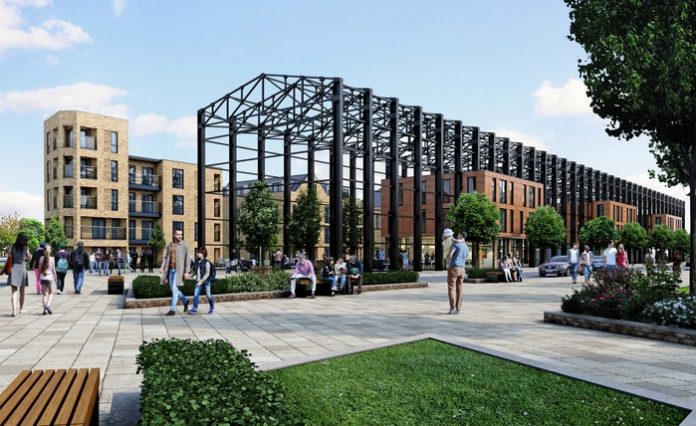The regeneration of the famous MG site in Longbridge where the iconic Mini was conceived has moved a step closer to fruition after the submission of a planning application by St. Modwen to Birmingham City Council which reflects the heritage, identity and aspirations of Longbridge.
The site covers 60 acres of brownfield land and compliments the government’s recent expansion of its Brownfield Land Release Fund. The fund forms part of a government strategy that prioritises building residential property on previously developed sites instead of building on green belt land.
The proposals will deliver new workspaces and homes for future generations in a mixed-use new district of Longbridge which builds on the site’s legacy, while bringing further economic growth and regeneration by creating around 1,300 jobs and 695 new homes in a sustainable new neighbourhood.
The new area will feature workspaces, including creative studios, office buildings and co-working facilities to cater for all businesses, together with a diverse mix of high-quality new homes for families and young professionals with access to the wide range of shops and leisure facilities in the town centre.
One of the fundamental aspects of the proposals is the preservation of iconic, heritage buildings which will be restored as part of the plans. Some of the redevelopment sites include the international HQ, the Roundhouse, the Car Assembly Building (CAB1), the Conference Centre, and the Dalmuir Road steps which will form a key connection to the town centre.
The new workspaces and homes will be set in over 10 acres of tranquil, green spaces which will boost biodiversity and the environment within the town, creating a healthier, vibrant location while supporting the well-being of the local community.
New footpaths and cycle routes will also be created to link the scheme with the heart of the town centre and surrounding attractions like Cofton Park, the Lickey Hills, the River Rea corridor and the recently enhanced Austin Park in Longbridge town centre.
Exciting new technologies have also been built into the plans in line with developer St. Modwen’s ambition to be operationally net zero carbon by 2025. The plans include the very latest energy efficient engineering, renewable energy sources, eco-friendly community facilities and electric vehicle charging points.
Rob Flavell, Senior Director for St. Modwen, said: “These plans represent a vital and exciting part of our vision to regenerate Longbridge. Our teams and partners have worked closely to create a development which will provide a fantastic area to work, live and visit while paying tribute to the historical importance and heritage of the site.
“Our plans represent more than just new buildings, but a thriving new community which will have its own distinctive character while bringing added benefits to the wider redevelopment of Longbridge town centre. Our plans have been put together with an eye on creating a high-quality, sustainable and attractive environment, which will improve the landscape, be kind to the environment and encourage biodiversity within the town.
“We’re looking forward to working alongside the local planning authorities to progress this application, and feel that this development will be hugely beneficial to the local community.”
Since regeneration began in Longbridge, St. Modwen has delivered 1,450 homes and 1m sq ft of commercial space, creating 3,000 fulltime jobs. On completion of the regeneration works, St. Modwen will create up to 2,800 new homes, 2 million sq ft of commercial floorspace and up to 10,000 jobs on at Longbridge. This will in turn deliver £500m of Gross Value Added (GVA) economic impact per year.



















